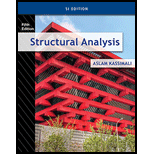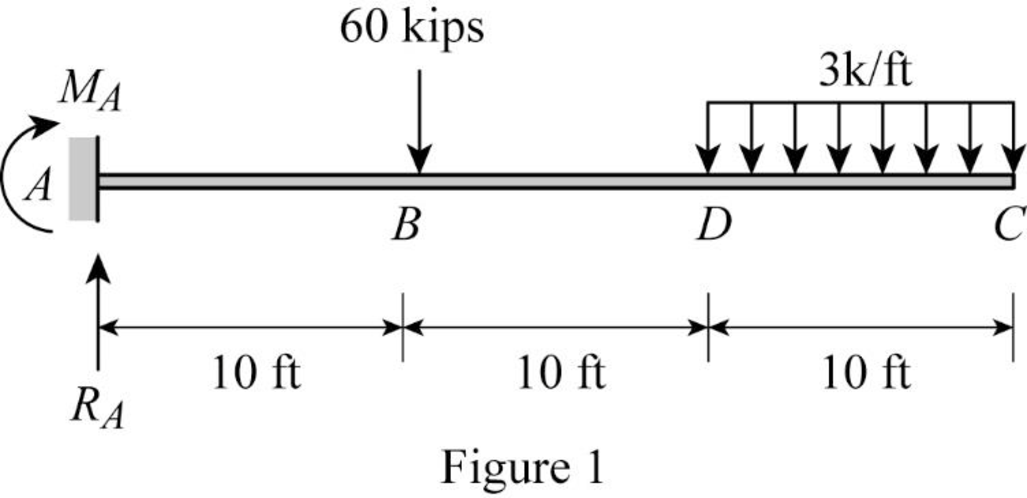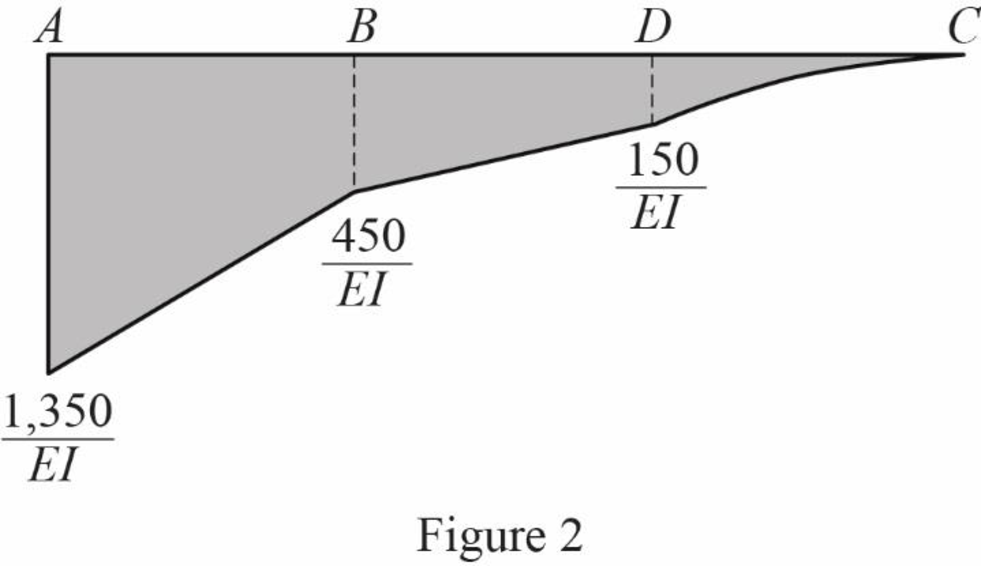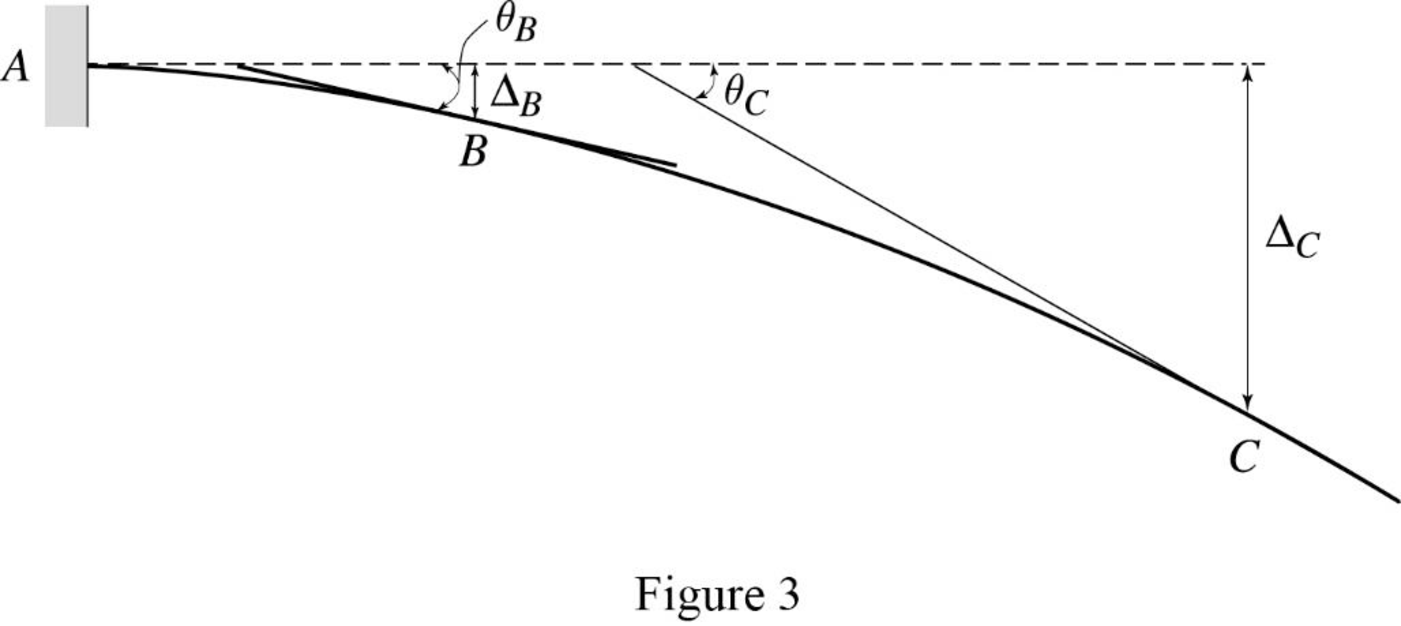
Concept explainers
Find the slope θB&θC and deflection ΔB&ΔC at point B and C of the given beam using the moment-area method.
Answer to Problem 16P
The slope at point B of the given beam using the direct moment-area method is −0.0112 rad_.
The deflection at point B of the given beam using the direct moment-area method is 0.782 in.(↓)_.
The slope at point C of the given beam using the direct moment-area method is −0.0155 rad_.
The deflection at point C of the given beam using the direct moment-area method is 4.227 in.(↓)_.
Explanation of Solution
Given information:
The Young’s modulus (E) is 29,000 ksi.
The moment of inertia (I) is 4,000 in.4.
Calculation:
Consider flexural rigidity EI of the beam is constant.
Show the free body diagram of the given beam as in Figure (1).

Refer Figure 1,
Consider upward is positive and downward is negative.
Consider clockwise is negative and counterclowise is positive.
Since support C is a free end there is no reaction.
∑V=0RA−(60+(3×10))=0RA=90 kips
Determine the bending moment at A;
MA−(3×10×102+20)−(60×10)=0MA=1,350 kips⋅ft
Determine the bending moment at B;
MB−1,350+(90×10)=0MB=1,350−900MB=450 kips⋅ft
Determine the moment at D;
MD+90×20−(60×10)−1,350=0MB=−1,800+1,950MB=150 kips⋅ft
Determine the bending moment at C;
MC−1,350+(90×30)−(60×20)−(3×10×102)=0MC=−2,700+2,700MC=0
Show the M/EI diagram for the given beam as in Figure (2).

Elastic curve:
The sign of M/EI diagram is negative; therefore, the beam bends downward. The support A of the given beam is fixed and the slope at A is zero. Therefore, the tangent to the elastic curve at A is horizontal.
Show the elastic curve diagram as in Figure (3).

The slope at point B can be calculated by evaluating the change in slope between A and B.
Express the change in slope using the first moment-area theorem as follows:
θB=θBA=Area of the M/EI between A and B=Area of triangle+Area of rectangle=12×b×h+(b1×h1)
Here, b is the width of the respective triangle and rectangle and h is the height of the respective triangle and rectangle.
Substitute 10 ft for b, 900EI for h, 10 for b1, and 450EI for h1.
θB=θBA=(12×900EI(10)+450EI(10))=1EI(9,000)=9,000 kips⋅ft2EI
Determine the slope at B using the relation;
θB=9,000 kips⋅ft2EI
Substitute 29,000 ksi×(12 in.1 ft)2 for E and 4,000 in.4×(1 ft12 in.)4 for I.
θB=9,000 kips⋅ft2(29,000 ksi×(12 in.1 ft)2)(4,000 in.4×(1 ft12 in.)4)=−0.0112 rad
Hence, the slope at point B is −0.0112 rad(Clockwise)_.
The deflection of B with respect to the undeforemd axis of the beam is equal to the tangential deviation of B from the tangent at A.
Express the deflection at B using the second moment-area theorem as follows:
ΔB=ΔBA=Moment of the area of the M/EI diagram between A and B about B=12×b×h×(23×b)+(b×h1)(b2)
Substitute 10 ft for b, 900EI for h, and 450EI for h1.
ΔB=ΔBA=(12×900EI(10)(23×10)+450EI(10)×102)=52,500 kips⋅ft3EI
Determine the deflection at B using the relation;
ΔB=ΔBA=52,500 kips⋅ft3EI
Substitute 29,000 ksi for E and 4,000 in.4 for I.
ΔB=ΔBA=52,500 kips⋅ft3×(12 in.1 ft)3(29,000 ksi)(4,000 in.4)=0.782 in.(↓)
Hence, the deflection at B is 0.782 in.(↓)_.
Express the change in slope using the first moment-area theorem as follows:
θC=θCA=θB+Area of the M/EI between A and C=θB+Area of rectangle+Area of triangle+Area of parabola=θB+(b×h)+(12×b×h)+(13×b×h)
Here, b is the width and h is the height of the rectangle, triangle, and parabola.
Substitute 9,000EI for θB, 10 ft for b, and 150EI, 300EI, and 150EI for h.
θC=θCA=9,000EI+((10×150EI)+(12×300EI×10)+(13×150EI×10))=12,500 kips⋅ft2EI
Determine the slope at C using the relation;
θC=12,500 kips⋅ft2EI
Substitute 29,000 ksi for E and 4,000 in.4 for I.
θB=12,500 kips⋅ft2(12 in.1 ft)2(29,000 ksi)(4,000 in.4)=0.0155 rad
Hence, the slope at point C is −0.0155 rad_.
The deflection of C with respect to the undeforemd axis of the beam is equal to the tangential deviation of C from the tangent at A.
Express the deflection at C using the second moment-area theorem as follows:
ΔC=ΔCA=Moment of the area of the M/EI diagram between A and C about C=[(lb(20+b2))+(12bh×(20+23b))+(lb(10+b2))+(12bh×(10+23b))+(13bh×(34b))]=[(450EI(10)(20+b2))+(12(10)(900EI)×(20+23×10))+(10(150EI)(10+102))+(12(10)(300EI)×(10+23×10))+(13(10)(150EI)×(34×10))]
ΔC=ΔCA=1EI(112,500+120,000+22,500+25,000+3,750)=283,750 kips⋅ft3EI
Determine the deflection at C using the relation;
ΔC=283,750 kips⋅ft3EI
Substitute 29,000 ksi for E and 4,000 in.4 for I.
ΔC=ΔCA=283,750 kips⋅ft3×(12 in.1 ft)3(29,000 ksi)(4,000 in.4)=4.227 in.(↓)
Hence, the deflection at C is 4.227 in.(↓)_.
Want to see more full solutions like this?
Chapter 6 Solutions
Structural Analysis, Si Edition
- Problem 2 (A is fixed and C is a pin) Find the reactions and A and C. 10 k- 6 ft 6 ft B A 2 k/ft 15 ftarrow_forward6. A lake with no outlet is fed by a river with a constant flow of 1200 ft3/s. Water evaporates from the surface at a constant rate of 13 ft3/s per square mile of surface area. The surface area varies with the depth h (in feet) as A (square miles) = 4.5 + 5.5h. What is the equilibrium depth of the lake? Below what river discharge (volume flow rate) will the lake dry up?arrow_forwardProblem 5 (A, B, C and D are fixed). Find the reactions at A and D 8 k B 15 ft A -20 ft C 10 ft Darrow_forward
- Problem 4 (A, B, E, D and F are all pin connected and C is fixed) Find the reactions at A, D and F 8 m B 6m E 12 kN D F 4 marrow_forwardProblem 1 (A, C and D are pins) Find the reactions and A, C and D. D 6 m B 12 kN/m 8 m A C 6 marrow_forwardUniform Grade of Pipe Station of Point A is 9+50.00. Elevation Point A = 250.75.Station of Point B is 13+75.00. Elevation Point B = 244.10 1) Calculate flowline of pipe elevations at every 50 ft. interval (Half Station). 2) Tabulate station and elevation for each station like shown on example 3) Draw Sketcharrow_forward
- quantity surveyingarrow_forwardNote: Please accurately answer it!. I'll give it a thumbs up or down based on the answer quality and precision. Question: What is the group name of Sample B in problem 3 from the image?. By also using the ASTM flow chart!. This unit is soil mechanics btwarrow_forwardPick the rural location of a project site in Victoria, and its catchment area-not bigger than 25 sqkm, and given the below information, determine the rainfall intensity for ARI = 5, 50, 100 year storm event. Show all the details of the procedure. Each student must propose different length of streams and elevations. Use fig below as a sample only. Pt. E-ht. 95.0 200m 600m PLD-M. 91.0 300m Pt. C-93.0 300m PL.B-ht. 92.0 PL.F-ht. 96.0 500m Pt. A-M. 91.00 To be deemed satisfactory the solution must include: Q.F1.1.Choice of catchment location Q.F1.2. A sketch displaying length of stream and elevation Q.F1.3. Catchment's IFD obtained from the Buro of Metheorology for specified ARI Q.F1.4.Calculation of the time of concentration-this must include a detailed determination of the equivalent slope. Q.F1.5.Use must be made of the Bransby-Williams method for the determination of the equivalent slope. Q.F1.6.The graphical display of the estimation of intensities for ARI 5,50, 100 must be shown.arrow_forward
